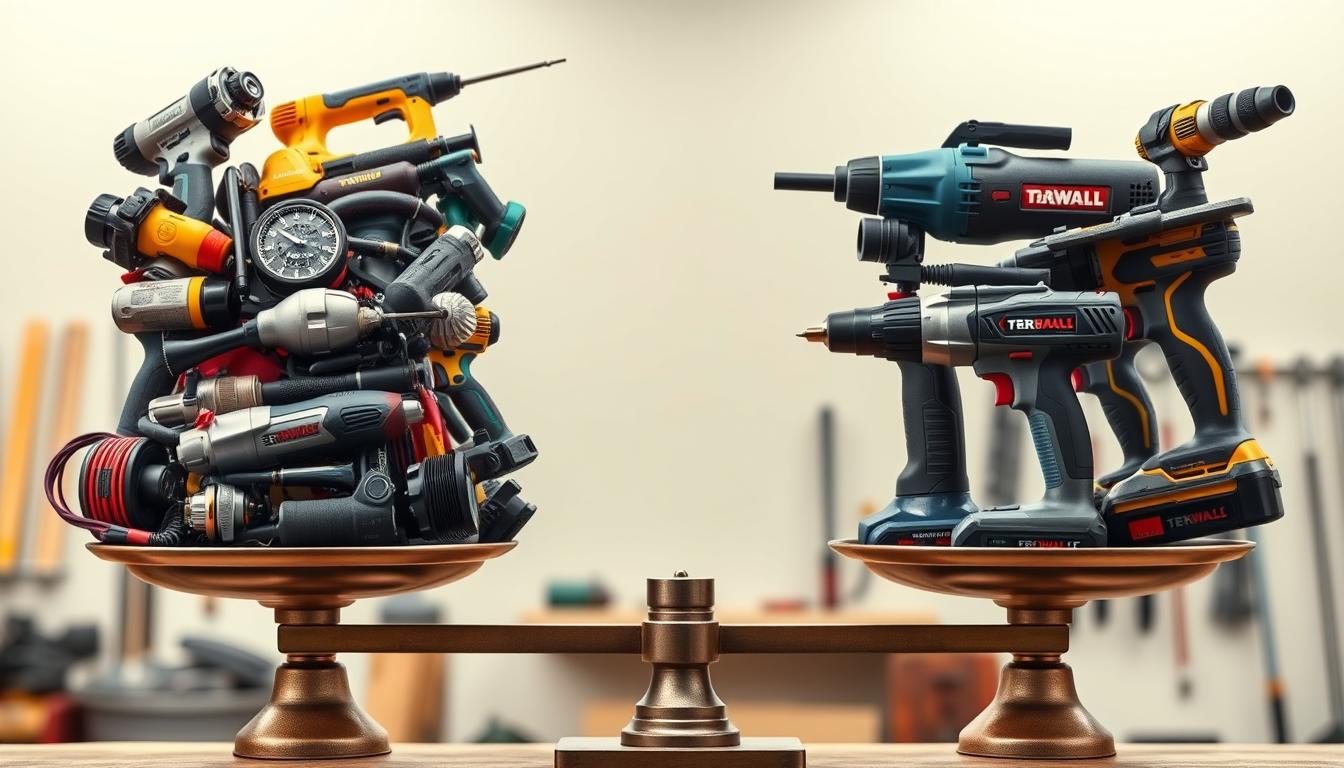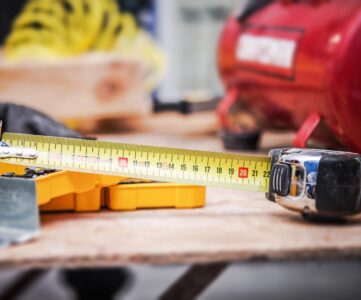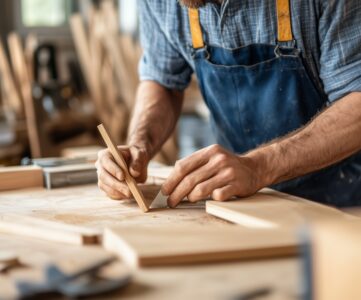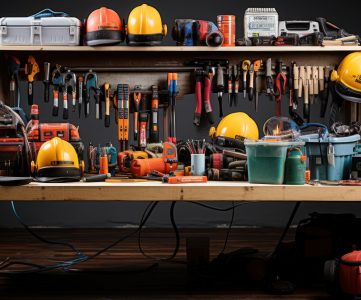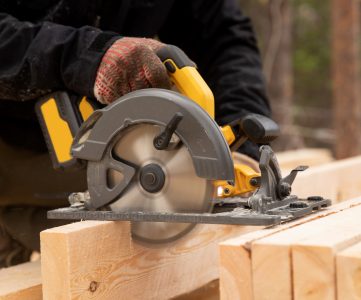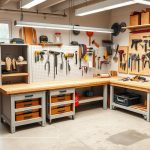Buying power tools requires smart choices to get the most value. The market offers many options, so it’s key to look at tool recommendations and value. This way, you can avoid spending too much on tools that aren’t worth it.
Choosing the right power tools means thinking about what you need and how much you can spend. By focusing on value and smart buys, you can get tools that work well without costing too much. This article will guide you through the world of power tools, offering tips on what to buy and how to make smart choices.
Introduction to Smart Tool Purchases
Understanding tool value is key to making smart buys. Not all power tools are the same, and some aren’t worth the cost. By looking at recommendations and what you really need, you can make choices that fit your budget and goals.
Key Takeaways
- Consider tool value when making power tool purchases
- Seek smart purchases to avoid overspending
- Evaluate tool recommendations to inform your decisions
- Assess your needs and budget before buying power tools
- Focus on making informed decisions to build a effective tool collection
- Recognize that not all power tools are worth the investment
- Tool value is crucial to making smart purchases
Understanding Tool Value: The Smart Buyer’s Approach
Buying power tools can be tricky. It’s key to know the value of each tool to avoid spending too much. A smart buyer looks at their needs, how often they’ll use the tool, and if they’re a pro or DIYer. This way, they find the best tool for their budget and needs.
First, think about what you really need. Look at the projects you’ll do and the tools needed for each. For example, a DIYer might not need a fancy drill press but a good cordless drill is a smart buy.
Assessing Your Actual Needs
Make a list of your projects and the tools needed for each. Then, look for tool alternatives that work well for these projects. This helps you make smart choices and avoid buying tools that aren’t worth it.
Frequency of Use Considerations
How often you’ll use a tool matters too. If it’s just for occasional use, renting or finding cheaper alternatives might be better. But, if you’ll use it a lot, investing in a quality tool is wise.
Professional vs DIY Requirements
Lastly, think about your level of expertise. Pros might need special tools for tough projects. But DIYers can often get by with simpler tools. Knowing your needs helps you invest wisely and avoid wasting money.
| Tool Type | Frequency of Use | Professional/DIY |
|---|---|---|
| Cordless Drill | Frequent | Both |
| Drill Press | Occasional | Professional |
| Saw | Frequent | Both |
Overpriced Cordless Tools to Avoid
Choosing the right cordless tools is key to saving money. With so many options, it’s hard to know which ones are worth it. Some popular brands charge too much, offering little extra value.
When comparing prices, some brands focus more on marketing than quality. This means you might pay more for a name than for what the tool can do. It’s important to look at what the tool can do, not just its brand.
Some tools to skip because they cost too much include:
- Drill drivers with too many features
- Expensive impact wrenches that don’t have enough power
- Saws that run out of battery too fast
Instead, find tools that are both good and affordable. This way, you can save money and still get the job done well.
When picking cordless tools, think about what you need and how much you can spend. This helps you avoid tools that cost too much and don’t offer much value. Always compare values and look for alternatives before buying.
The Truth About Premium Brand Marketing
Many people trust premium brand marketing when buying tools. But, it’s key to know if the brand is really worth it. A good value comparison helps buyers choose wisely, not just by brand name.
A buying guide can also guide you through the market. It helps you spot overpriced tools. Think about how often you’ll use the tool and if you need it for work or DIY projects. Also, consider the extra costs of buying a brand name. It’s important to look at the tool’s real performance and how long it lasts.
When checking out premium brand marketing, keep these points in mind:
- Marketing tactics: Watch out for emotional appeals, limited-time offers, and celebrity endorsements.
- Hidden costs: Think about the extra costs of brand names, like higher prices and maintenance.
- Actual quality: Check reviews, ratings, and comparisons to see how well the tool really works and lasts.
By examining premium brand marketing, you can make better choices. A detailed buying guide helps you find the best tools for your money. This way, you can get the most value without spending too much.
A smart buyer looks at value, quality, marketing, and hidden costs. This way, they make better choices and get the most from their budget.
Common Power Tool Features You Don’t Really Need
When buying power tools, comparing values is key to getting the right tool. A good buying guide helps you understand the features and options. But, some features might not be as important as they seem. We’ll look at common power tool features you might not need, helping you make smart choices.
Understanding what features are must-haves is crucial. By knowing your needs, you can tailor a buying guide that focuses on what matters most. This involves comparing different tools and their abilities.
Features like advanced LED lighting, Bluetooth, and high-torque motors might not be essential. They can be pricey but useful in some cases. By thinking about your needs and weighing the pros and cons, you can choose wisely and stay within your budget.
To make a smart choice, prioritize your needs and create a personalized buying guide. This way, you’ll get the best value and the right tools for your tasks. Always consider the value comparison and tool recommendations to make the best decision.
Smart Alternatives to Expensive Power Tools
It’s easy to get caught up in the latest power tools. But, many can be a waste of money. Look into tool alternatives that save you cash. Manual tools like hand saws and chisels are great for small projects. Renting tools is also a smart way to use expensive tools without a big commitment.
For budget-friendly options, consider these:
- Manual sanders for small woodworking projects
- Hand drills for occasional use
- Rental circular saws for large-scale projects
These alternatives help you avoid spending too much on tools you don’t use often. By looking for alternatives, you can find tools that are both affordable and effective.
Finding smart alternatives to expensive tools means knowing what you really need. Think about how often you’ll use a tool. This way, you can choose wisely between buying, renting, or using manual tools. This approach saves you money and ensures you have the right tools for your needs.
When Budget Tools Actually Outperform Expensive Ones
In the world of power tools, it’s common to think that pricey tools are always best. But, this isn’t always true. Many times, budget tools can do just as well, if not better, than their pricier rivals. This makes them a waste of money for many users. By comparing values, you can figure out which tools are worth the cost.
Budget tools often stand out because of their simplicity. They lack fancy features but are more dependable and straightforward to use. For instance, a basic cordless drill from Black+Decker can outdo a pricier DeWalt model for DIY tasks.
Here are some perks of picking budget tools:
- Lower upfront cost
- Often simpler and more reliable
- Can be just as effective for DIY projects
By weighing these points and doing a detailed value comparison, you can choose the right tools for your needs. This way, you avoid spending too much on tools that don’t add much value. With smart tool alternatives, you can accomplish your tasks without spending a fortune.
The Hidden Cost of Multi-Function Tools
When you think about buying tools, it’s key to weigh the pros and cons. A good buying guide can help, but don’t just look at the price tag. Multi-function tools might seem handy, but they can make you a jack of all trades, master of none.
In a value comparison, think about the long-term gains and losses. Single-purpose tools might cost more at first, but they often last longer and work better. Multi-purpose tools are cheaper, but their flexibility might mean they’re not as good.
Here are some important things to think about when choosing tools:
- Single-purpose tools often provide better performance and longevity
- Multi-purpose tools can be more affordable, but may compromise on quality
- A buying guide can help you make an informed decision based on your specific needs
Choosing between single-purpose and multi-purpose tools depends on what you need and want. By looking at the value comparison and tool investment, you can pick the right tools for your budget and needs.
| Tool Type | Initial Cost | Long-term Benefits |
|---|---|---|
| Single-purpose | Higher | Better performance, longevity |
| Multi-purpose | Lower | Versatility, potential compromise on quality |
Essential Power Tools Worth Their Price Tag
When you’re looking to buy power tools, think about their long-term value. Some tools might cost more upfront, but they can save you money and time in the long run. We’ll look at tools that are worth the investment, helping you find the best value for your money.
It’s important to know how often you’ll use a tool and what your projects need. This helps you pick the most important tools for your toolkit. For example, a top-notch drill press or a dependable impact driver can save you a lot of time and effort.
Investment-Worthy Tools
Some power tools are worth their price because they last long, work well, and are versatile. These tools make your work easier and faster, making them a smart choice for anyone who loves DIY or is a pro. By comparing values and brands, you can avoid spending too much on tools that aren’t worth it.
Long-Term Value Considerations
When looking at power tools, think about the long-term benefits and savings. Choosing durable, high-quality tools means you won’t have to replace them as often. This saves you money and hassle. Plus, the right tools help you work faster, letting you take on more projects and earn more.
By making smart choices and investing in key power tools, you’ll build a reliable toolkit. Always look at recommendations and compare values to get the best deal. And don’t hesitate to spend on quality tools that will save you money and time in the long run.
How to Maximize Your Tool Investment
To get the most out of your tool investment, think about a few key things. A smart tool investment helps you avoid buying tools you don’t need. This way, your tools will last longer and work better for you.
Keeping your tools in good shape is key. Clean them often, apply lubricant when needed, and store them in a dry spot. These steps help prevent rust and damage. This means you won’t have to spend a lot on repairs or new tools.
Maintenance Tips for Longevity
- Regularly clean your tools to prevent dirt and debris buildup
- Lubricate moving parts to reduce friction and wear
- Store tools in a dry, secure location to prevent damage and loss
By following these tips and choosing your tools wisely, you can save money. This way, your tools will stay in top condition. They will keep working well for you for a long time.
Conclusion: Building Your Smart Tool Collection
Building a smart tool collection starts with strategic purchases. It’s important to understand your needs and look for smart purchases. This way, you can get the most value from your tools without spending too much.
Don’t assume the most expensive tool is the best. Look beyond the brand names and marketing. Find tools that really meet your needs and work well for you. With some research, you can find great, affordable options.
The aim is to have a tool collection that’s versatile and high-quality. It should meet your DIY or professional needs without costing too much. By following the advice in this article, you’ll build a valuable tool set that will last for many years.
